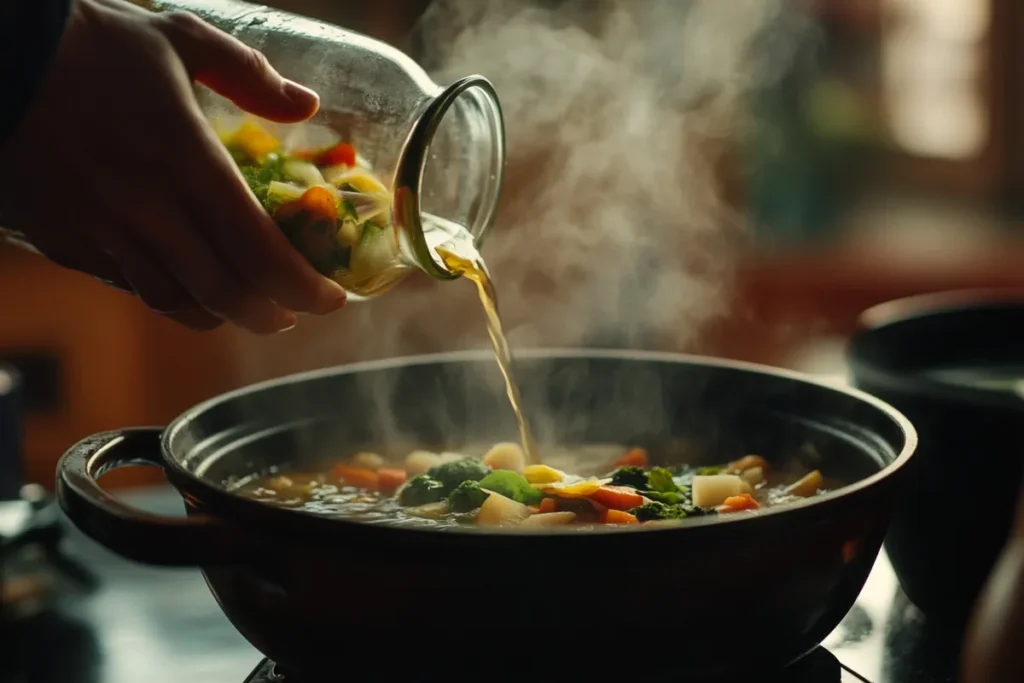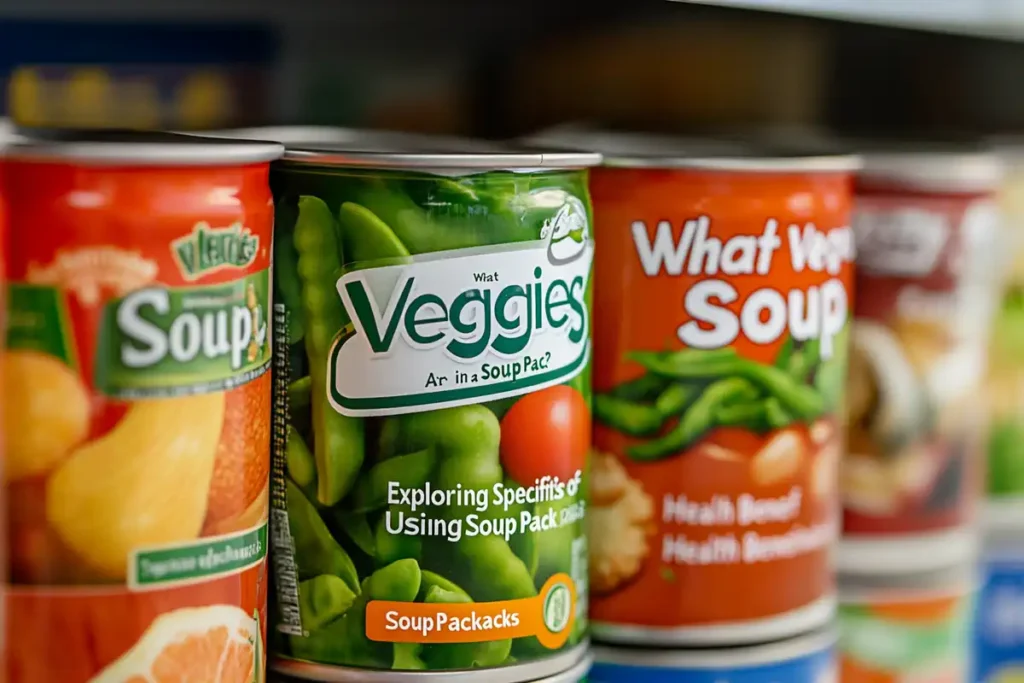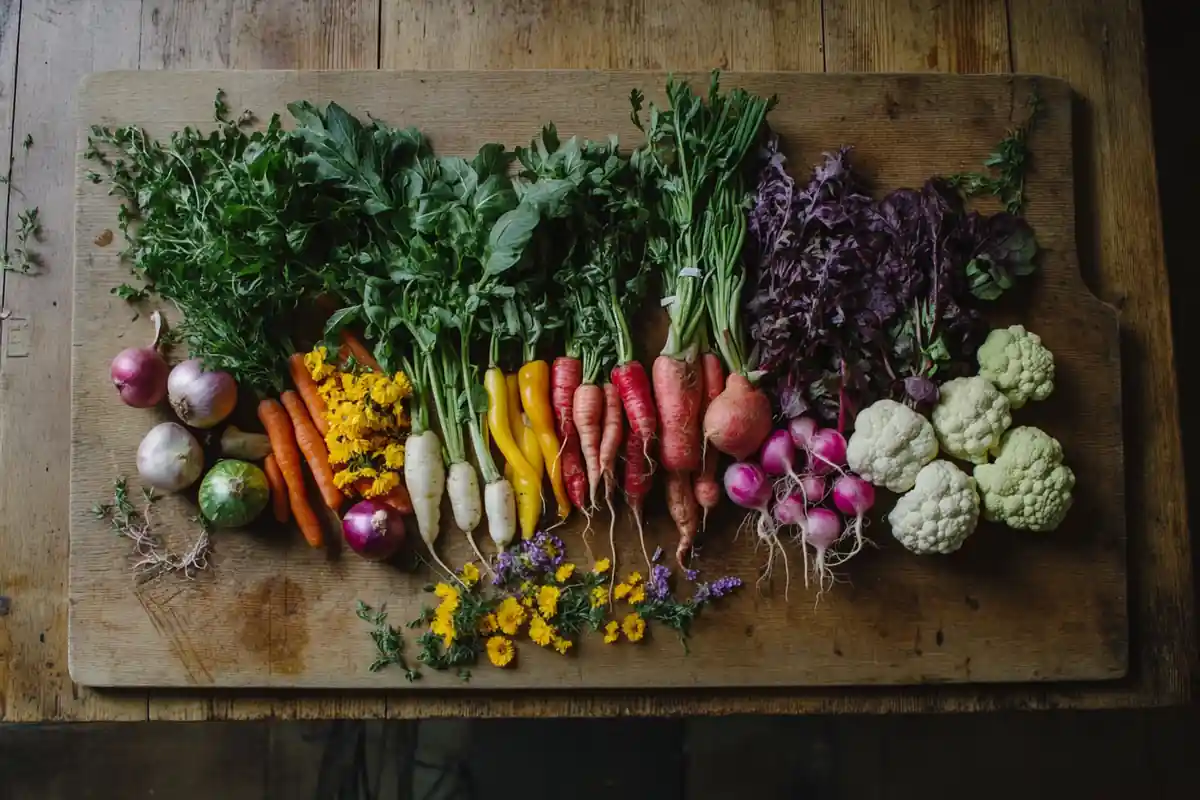Discover what veggies are in a soup pack and learn how to use them effectively. This detailed guide will help you create delicious, nutritious soups using the convenience of pre-packaged vegetables. We’ll explore common contents, offer cooking tips, and provide creative recipe ideas.
Soup is a beloved comfort food, and using a soup pack can greatly simplify the cooking process. But the question often arises: what veggies are in a soup pack? This comprehensive guide will explore the typical vegetables you’ll find, how to make the most of them, and how to elevate your soup making with these convenient mixes. Whether you are a seasoned cook or a beginner, this information will be useful. We’ll cover different types of vegetable combinations and some creative ways to utilize them.
Table of contents
Understanding the Contents of a Soup Pack
Knowing what veggies are in a soup pack is the essential first step to creating truly great soup. These packs usually contain a carefully selected mix of vegetables that form a foundational base for a wide variety of soup recipes. The convenience they offer is a major advantage for busy cooks. They eliminate a significant amount of prep work and make it far easier to prepare a healthy meal. Let’s explore the typical components and what they bring to the table.
Common Vegetables Found in Soup Packs
Most soup packs will include some combination of these widely used and well-loved vegetables:
- Carrots: These add a subtle sweetness, a vibrant color, and a good amount of nutrients.
- Onions: These provide a savory base note and a wonderful aroma.
- Celery: This brings a subtle, fresh, and slightly peppery flavor.
- Potatoes: These contribute a hearty texture and can make a soup much more filling.
These four vegetables are the core elements you will most frequently find. They form the foundation of countless different soup styles and recipes. What veggies are in a soup pack can vary slightly from one brand to another, but this combination represents the general standard.
Variations in Soup Pack Contents
While the core vegetables remain generally consistent, some soup packs may include other flavorful additions, such as:
- Leeks: These offer a milder onion-like flavor, and a slight sweetness.
- Turnips: These add a slightly peppery taste and can also contribute to a creamy texture.
- Parsnips: These contribute a sweet, earthy note, and are very similar to carrots.
- Garlic: This brings a strong, savory element, enhancing the overall taste of the soup.
These vegetables add extra flavor, depth, and nutrients to the soup. The range of variations in soup pack contents allows you to experiment and find the particular vegetable mix that best suits your palate and cooking style. Therefore, carefully examining the label is always a good idea. This helps you understand exactly what veggies are in a soup pack that you are considering purchasing.
The Convenience of Pre-packaged Vegetables
The sheer convenience of using a soup pack cannot be overstated. It saves you a great deal of time, eliminating the often tedious tasks of chopping, peeling, and prepping each individual vegetable. The vegetables are typically pre-washed, pre-cut, and ready to use directly from the package. This is a particularly appealing feature on busy weeknights when time is scarce. These pre-cut vegetables allow you to focus on other essential steps of making a delicious, home-cooked soup. Knowing what veggies are in a soup pack lets you start cooking right away, making meal preparation so much faster.
How to Use Your Soup Pack Effectively

Simplify soup making using pre-cut vegetables.
Knowing what veggies are in a soup pack is certainly beneficial, but understanding how to use them effectively is paramount. Here are some proven tips for making the most of your pre-packaged soup vegetables.
Sautéing for Enhanced Flavor
Before adding your soup pack to the simmering broth, consider sautéing the vegetables in a bit of olive oil, butter, or even a small amount of bacon fat for an added flavor boost. This process helps to bring out the vegetables’ natural sweetness and intensifies their overall flavor profile. It only takes a few minutes, but the difference in taste is very noticeable. Sautéing also softens the vegetables slightly, which can make them even more pleasant and enjoyable in your final soup.
Adding Additional Vegetables
While soup packs offer great convenience, you can always add additional vegetables to further increase the nutrient content, flavor complexity, and visual appeal. Consider adding:
- Spinach: This is very full of vitamins and cooks very quickly.
- Mushrooms: These add a wonderful earthy flavor and a meaty texture.
- Peas: These offer a pop of sweetness and a vibrant green color.
- Tomatoes: These contribute acidity and a fresh, summery taste.
- Zucchini: They have a mild flavor that blends well.
Adding these types of vegetables will not only improve the overall taste but also make your soup even more nutritious and satisfying. Always think carefully about what veggies are in a soup pack already, and then add any favorites that you think would go well. This allows for great customization.
Using Soup Packs in Different Recipes
Soup packs are definitely not limited to just basic soup recipes. They can be used in many other dishes. They work wonderfully in:
- Stews: They provide a mix of vegetables that make the stew heartier and more flavorful.
- Chilis: The vegetables add depth of flavor, essential nutrients, and extra bulk.
- Broths: They create a solid foundation for a flavorful and healthy broth.
- Sauces: They can be cooked down and blended into a smooth and delicious sauce.
The inherent versatility of a soup pack makes it an extremely useful and valuable item to keep in your kitchen. Don’t limit your creativity! You do not have to restrict their use to just simple, basic soups.
What Veggies Are in a Soup Pack? Exploring Specific Combinations

Discover the numerous variations available in soup packs.
Let’s take a closer look at some specific types of soup packs. This will help you to further understand the commonly used vegetable combinations. This knowledge will greatly assist you in selecting the most suitable pack for your individual cooking needs. Understanding what veggies are in a soup pack is an essential part of successful cooking.
Mirepoix: The Classic Soup Base
A mirepoix is a well-known, classic vegetable mix that is frequently used in many culinary applications. It typically contains the following three vegetables:
- Onions
- Carrots
- Celery
This is a standard, go-to base for countless soups, stews, and sauces around the world. These three vegetables work together in perfect harmony, creating a very harmonious and flavorful combination. This widely used combination can easily be found in many soup packs at any grocery store.
What’s in a Soup Kit? Different Varieties
Some soup kits go beyond just basic vegetables. They often include other beneficial items, such as:
- Beans: These add a great source of protein and fiber to the dish.
- Lentils: These offer a heartier base, and are full of fiber.
- Pasta: This makes the soup much more satisfying and substantial.
- Seasoning: This is included to enhance the flavor and aroma.
If you have ever asked the question what’s in a soup kit, these are the types of variations you should look for. These types of kits frequently provide all of the ingredients you need to create a complete and well-balanced meal. This is very convenient for busy individuals.
What is in a soup greens package?
A soup greens package will generally include a mix of leafy greens, such as:
- Kale
- Collard greens
- Mustard greens
- Spinach
These types of leafy greens add plenty of important vitamins, minerals, and other beneficial nutrients to your daily intake. Knowing what is in a soup greens package will help you add more of these highly beneficial vegetables to your everyday diet. They also cook very quickly and add a considerable amount of vibrant freshness to your meals.
Health Benefits of Using Soup Packs
Incorporating a soup pack into your meals can be an extremely healthy choice. They represent a very simple and effective way to add a variety of vegetables to your diet. Here are some of the many potential health benefits. It is also always helpful to know what veggies are in a soup pack to better understand the nutritional value.
Rich in Vitamins and Minerals
Vegetables are renowned for being full of essential vitamins and minerals. These nutrients are, of course, crucial for maintaining good overall health and well-being. By simply using a soup pack, you are making it considerably easier to obtain these vital nutrients every day. It is a simple way to make certain that you are eating well.
Good Source of Fiber
Vegetables are also a fantastic source of dietary fiber. Fiber plays a crucial role in helping with healthy digestion, and also helps to keep you feeling full and satisfied for much longer periods of time. This will also greatly assist with weight management. Knowing what veggies are in a soup pack allows you to select the best vegetable mix to best meet your own personal needs.
Lower in Calories
Most vegetables are naturally quite low in calories. This makes them an extremely beneficial addition to virtually any kind of meal plan. By using a soup pack, you can easily create a very satisfying, healthy, and well-balanced meal without adding a lot of extra calories. It’s a very conscious approach to eating, and promotes a healthy lifestyle.
Convenient Way to Add Vegetables
Using a soup pack is an incredibly fast and easy method for increasing your daily vegetable consumption. It eliminates all of the time-consuming steps of extensive chopping, peeling, and prep work. This makes it more likely that you will regularly include vegetables in your daily meals, especially if you have a busy life. It’s truly a win-win choice for most people.
Tips for Choosing the Best Soup Pack
Selecting the best soup pack really depends on your individual needs, taste preferences, and cooking style. Here are several practical tips that will guide you in making the best choices. Knowing what veggies are in a soup pack is always a great place to begin the process.
Check the Labels
Always take the time to carefully check the labels. These labels will provide you with the exact information you need, telling you precisely what veggies are in a soup pack you are considering. The labels will also show you any additives or unwanted preservatives. Selecting soup packs with the minimal amount of additives is usually the best approach for overall health.
Consider Your Taste Preferences
Think about which vegetables you personally enjoy the most. If you are not a fan of leeks, for example, then try to avoid soup packs that include them. Always choose a mix that best suits your own personal taste preferences and desired flavor profiles.
Look for Variety
A soup pack that contains a good mix of different vegetables will, in most cases, offer a broader array of nutrients and will also result in a more complex and interesting flavor profile. Look for a good balance of different colors, textures, and types of vegetables when you are making your selection. This will lead to more enjoyable and satisfying meals.
Opt for Freshness
Whenever possible, try to choose soup packs that contain fresh looking vegetables. Avoid any packs where the vegetables appear wilted, discolored, or otherwise unappealing. The freshness of the vegetables will make a significant difference in both the overall taste and the nutritional value of your meals.
Creative Ways to Use a Soup Pack
There are countless creative and diverse ways to use a soup pack that go far beyond the typical use of just making a basic soup. Here are a few exciting ideas to provide you with some inspiration. Knowing what veggies are in a soup pack can certainly help you to get creative.
Vegetable Frittatas
Sauté the vegetables from the soup pack and add them to a frittata or scrambled eggs for a quick, easy, and protein-rich meal. This is an excellent way to make use of any leftover vegetables you might have in your fridge. This is also a very healthy and satisfying option for breakfast, brunch, or even dinner.
Roasted Vegetables
Toss the vegetables with some olive oil, salt, pepper, and any other seasoning you desire, and then roast them in the oven. This roasting method is highly effective at bringing out the natural sweetness and flavors of the vegetables. Roasted vegetables are a very simple, yet elevated side dish that pairs well with just about anything.
Vegetable Stir-Fries
Use the vegetables in a stir-fry with rice or noodles. Add your favorite sauces, proteins, and seasoning for a fast, flavorful, and extremely healthy meal. It’s a very convenient method for getting a delicious meal on the table in a short period of time.
Vegetable Sauces
Cook the vegetables until they are tender, and then blend them into a smooth and creamy sauce. You can use this sauce for pasta, meats, or any other of your favorite foods. This also provides an opportunity to add more nutrients and flavor to all of your regular meals. It’s an easy, convenient, and extremely versatile option for any home cook.
Conclusion
Knowing what veggies are in a soup pack is an extremely helpful piece of information for creating a variety of healthy, delicious, and satisfying meals. Soup packs offer incredible convenience, and also a very beneficial source of vital nutrients. They help save you precious time and effort, especially when you have a busy schedule. They are also incredibly versatile and can be used in so many creative and exciting ways. By embracing these pre-cut mixes of vegetables, you have the opportunity to make a countless number of different types of dishes with ease and confidence. They are truly an invaluable asset to any home cook.
Frequently Asked Questions (FAQs):
Many vegetables work well in soup. Common choices include carrots, celery, onions, potatoes, zucchini, spinach, and mushrooms. You can use a wide variety to make your soup more nutritious and tasty.
A soup pack typically contains a mix of vegetables like carrots, onions, celery, and potatoes. Some packs may also have leeks, turnips, or other variations. The exact contents will vary between different packs.
A soup greens package usually includes leafy greens. Common options are kale, collard greens, mustard greens, and spinach. These add extra vitamins and nutrients to your soup.
A soup kit might contain vegetables, beans, lentils, pasta, and seasoning. They often provide most of the ingredients you need for a complete soup. This simplifies your meal preparation process.

